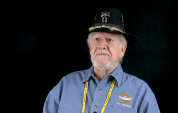7:31 | After completing flight school and advanced training, Parker went over on a plane to Vietnam. Although he was qualified to fly OH-23 Helicopters, he preferred to fly Hueys. On one occasion, he was helping the gun platoon drop CS and ended up staying with them in Ban Me Thuot for a few weeks. During this, on the night of his 25th birthday, there was a rocket attack and Parker never left his tent. Another time he shot a UFO with a minigun, and it turned out to be an Army Mohawk pilot that had forgotten to clear himself.
Keywords : John Parker Vietnam Gun Platoon tent Huey Helicopter Minigun Unidentified Flying Object (UFO) friendly fire Al Calida Walt Moss OH-23 Ban Me Thuot rocket attack mohawk plane

Although John Parker was born in Taylor, Texas, his family was always moving around because his father was in the Army for over 20 years. Despite this, Parker never really thought about joining and was instead drafted for Vietnam. He went to Fort Sill for Artillery Officer Candidate School, and went to flight school at Fort Wolters.
Parker remembers his interactions he had with civilians, including those of the Montagnard. There was a village that they took care of, and one time there were threats of a Viet Cong attack. To combat this, Parker went with a few other men to spend the night in the village and keep watch for any VC. While that incident never resulted in the VC coming, there was another time that there was a full scale attack of that village.
Parker talks about the types of missions he had as part of a gun platoon, as well as how he became an aircraft commander. After some time, Cobra Helicopters were being introduced to the Vietnam War and, as a result, he went to Cobra School in Bien Hoa to learn the ins and outs of flying them. There was a casualty where one of his friends made a miscalculation in the air and flew into the side of a mountain.
A very memorable mission for Parker was the time he had to help save a total of 10 Air Force men from a dangerous North Vietnamese attack. They were trapped in a hole in Cambodian territory, and it was up to him to fly over and pull them out. He had to try multiple methods in order to keep the NVA's heads down during the rescue.
After his first tour was up, John Parker was allowed to come home to the US. Since he was returning with newfound knowledge on how to fly Cobras, he was instructed to go to Hunter Army Airfield in Savannah, Georgia to be a Cobra School training officer. In November of 1969, he was married and afterwards had his first son. This was quite interesting timing because this happened right before his second tour in Vietnam began.
In April of 1972, John Parker started his second tour in Vietnam. He remembers the Battle of An Loc and how the North Vietnamese were trying to go through to get to Saigon but were stopped for the time being. And he reflects on the loss of several Cobras and the crews that he knew.
After a while of fighting back the NVA, the end of the Battle of An Loc was upon Parker and his men. It was at this point that a lot of US troops had started to come home, and he was instructed to go to Da Nang to help support the effort over there. By the time the 1st Cavalry Division was instructed to return home, Parker didn't have enough points yet so he joined up with the 17th Cavalry Division instead.
Still in support of the South Vietnamese, it wasn't long before John Parker took over the Cobra Platoon for his division. Unfortunately, around this time he saw Camp Ben Het fall to the north, in addition to a village close by. The North came in with full tanks and open fired on the camp until there wasn't very much left. On another mission, he let another pilot borrow his carbine on his way to Kon Tum.
Parker had spent a lot of time in Vietnam and working for the military. He gives his final thoughts about the war, his reflections about how it has affected him, and what he wants people to remember about the war in Vietnam.